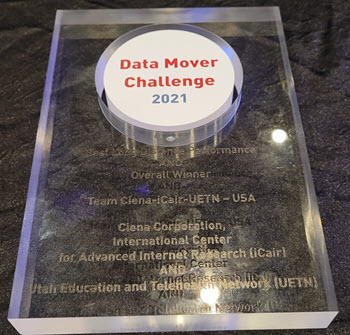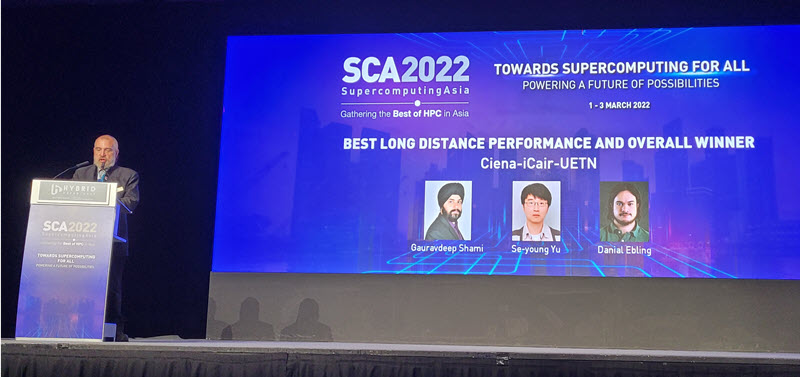More than a photon cannon: What iCAIR, UETN and Ciena won at the Data Mover Challenge and what this means for tomorrow’s network
Above: A/Prof Tan Tin Wee, Chief Executive, National Supercomputing Centre (NSCC) Singapore & Co-Chair of the SCA22 Steering Committee (left), presenting the award for “Best Long-Distance Performance AND Overall Winner” to Rick Seeto representing Team Ciena-iCAIR-UETN (right) at the SCA22 Conference in Singapore.
 When Singapore’s National SuperComputing Center (NSCC) put out a worldwide challenge to demonstrate the fastest end-to-end data transfer across the world, we in partnership with the International Center for Advanced Internet Research (iCAIR) at Northwestern University and Utah Education and Telehealth Network (UETN), naturally threw our hat into the ring. Taking home not one, but two awards – Best Long Distance Performance AND Overall Winner – is something we are very proud to be part of considering the level of competition and the incredible task at hand.
When Singapore’s National SuperComputing Center (NSCC) put out a worldwide challenge to demonstrate the fastest end-to-end data transfer across the world, we in partnership with the International Center for Advanced Internet Research (iCAIR) at Northwestern University and Utah Education and Telehealth Network (UETN), naturally threw our hat into the ring. Taking home not one, but two awards – Best Long Distance Performance AND Overall Winner – is something we are very proud to be part of considering the level of competition and the incredible task at hand.
In short, there was much, much more to the challenge, dubbed the Data Mover Challenge (DMC), than demonstrating the best “Photon Cannon”. And what we were able to achieve will fast-forward innovation and capability for the networking world.
What we needed to do
If it were just about speed and capacity, the contest would have been much more straightforward than the headline challenge posed by the DMC to “develop and demonstrate fastest end-to-end data transfer across Asia, Australia, North America and Europe on fully operational Research Networks utilizing multiple 100Gpbs links.”
But the devil is in the details, and contestants needed to demonstrate the following capabilities:
- The ability to tune the system
- To orchestrate various data transfer protocols
- To showcase a data management entity
- Provide security and identity management
- Show real-time predictive analytics and system monitoring, and
- Operate over global R&E network infrastructure and yield real-world data transfer results.
If that sounds complex, detailed and arduous to achieve, let alone come out on top of the competition, it’s because it is.
Thankfully, going into the contest, we were a match fit.
Preparing for Competition
Prior to the competition, Ciena’s CTO Group - External Research Team had already been active contributors in developing high-performance computing servers with integrated networking capabilities in partnership with the iCAIR for several years.
Called Data Transfer Nodes (DTNs), the servers attempt to integrate massive storage capacity, optimized computer design and integrated optical networking into a platform system capable of launching large reliable bulk data transfer at maximum speed. Computational intensive science is able to produce mammoth data sets extremely quickly, and DTNs are important to scientists and researchers that need to share this data across the planet in as close to real-time as possible.
For example, the Sloan Digital Sky Survey telescopes capture the night sky, mapping over 200 million objects, every observable night. This data needs to be moved from telescopes to partner researchers anywhere, and quickly.
Many research networks rely on Ciena for ultra-reach and high-capacity infrastructures, including our partners at iCAIR and UETN, as well as many of the participating research networks being used for the challenge. These world-renowned organizations operate networks that serve the needs of universities, educators and researchers conducting data intensive science and rely on Ciena’s solutions to meet their requirements.
Our technical expertise ensured we went into the competition confident -- but the demands set by the Data Mover Challenge were a stretch for every contestant, including us.
What we achieved
Our CTO Group research leader Gauravdeep Shami and director Marc Lyonnais worked with iCAIR Executive Director Joe Mambretti, UETN CTO Jim Stewart and designers Se-young Yu from iCAIR and Danial Ebling from UETN to optimize existing DTN constructs in several important ways that caught the eyes of the judges.

None of this was as simple as it may sound, and it pushed us beyond our system capabilities.
System initialization set a baseline of operating parameters that profiled all the servers’ operating characteristics; everything from Operating System kernel parameters to CPU temperatures, disk I/O and TCP parameters. Network parameters such as latency, jitter, packet loss, and link speed were all captured. An old management adage states that if you can’t measure it, you can’t control it. With this effort we took this adage one step further with a computer network science theme: And if you can’t control it, you can’t improve it.
Award-winning improvements were derived from Host Tuning techniques, Network Tuning for optimized data flows, buffer flow adjustments, Fair Queuing and Packet pacing, Improved data management and transfer streamlining, and, analytics and performance feedback and display mechanisms. In addition, secure access & authentication were added to meet security requirements and reduce potential system abuse.
To achieve the highest attainable throughput per application on-the-fly, an agile, AI-assisted flow optimization technique that adapted to changing network characteristics, computer operation conditions, and storage I/O dynamics was utilized to great effect and yielded good results.
Ultimately, the solution prepared by our team was recognized as the overall winners. Further, this design operated in ways that not only ticked all the boxes but provided the fastest transfer speeds against all test requirements.
Why this matters
The awards we received – Best Long Distance Performance, and the award for Overall Winner – are a fantastic validation of the technical expertise and exceptionalism Ciena’s team and our partners iCAIR and Utah Education and Telehealth Network (UETN) were able to demonstrate.
But this competition, for us and our partners, has provided us with more than two awards.
The awards we received – Best Long Distance Performance, and the award for Overall Winner – are a fantastic validation of the technical expertise and exceptionalism Ciena’s team and our partners iCAIR and Utah Education and Telehealth Network (UETN) were able to demonstrate.
Massive data flows generated by advanced computational applications drive technological evolution, and Research and Education Networks are often the first adopters of revolutionary technologies. We’ve seen this countless times through history. The Space Race rocketed NASA’s – and the nation’s – scientific and technological capabilities forward exponentially. Most recently, the technology developed to accelerate particles for the Large Hadron Collider, known for discovering the Higgs Boson, is in turn creating a new generation of compact accelerators with applications ranging from security to cancer treatment.
Only through pushing boundaries can we find what is beyond them, and this competition helped Ciena and its partners develop new capabilities which will prove a boon for the R&E networking world and beyond. These learnings are then shared with our product development teams to start applying them.
Our work on DTNs proved they are now more than simply appliances for data storage and forwarding. They offer a systems approach that blurs the lines where computers interface to networks. We have now reached a point where the network is part of the scientific apparatus, and capabilities developed for the Data Mover Challenge prove the network is the computer and the computer is the network.
The awards are a monumental testament to the innovation required to win. What we do with that innovation from here on out will help to drive networking technologies forward for years to come.





